- Home
- Knowledge library
- How to set up electric fencing for cattle and sheep
How to set up electric fencing for cattle and sheep
Read our advice on the differing fencing methods for cattle and sheep. You will find information on health and safety, identifying faults and common pitfalls.
Planning for fencing
Forward planning is essential to save time and energy when it comes to erecting the electric fence out in the field.
Things to think about before erecting the fence
- Type of fence – permanent, semi-permanent or temporary?
- Appropriate post spacing and wire height for type of livestock.
- Length of fence required, number of posts needed, and energiser output required.
- Are stronger posts required for corners or changes of direction?
- Plan where gateways will be best placed for livestock movement.
- Power source – mains, battery or dual-power unit?
Need more information? See our advice:
Types of electric fencing for cattle and sheep
Components of an electric fence
Cattle
Cattle are very sensitive to electric fences, so a single strand of wire 90 cm off the ground is suitable. However, if both cows and calves are grazing, two strands are required.
If using more than one strand of wire, make sure the live wire, which is connected directly to the power source, is at nose height.
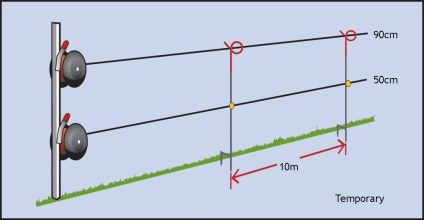
Sheep
Permanent fencing
If setting up permanent fencing, you may need up to five strands of wire for sheep. Place the lowest three strands at 15 cm intervals from the ground and the highest two at 25 cm intervals. Often, grass can short out the lowest wire. The ideal spacing from the bottom up is 15 cm, 30 cm, 45 cm, 65 cm and 90 cm.
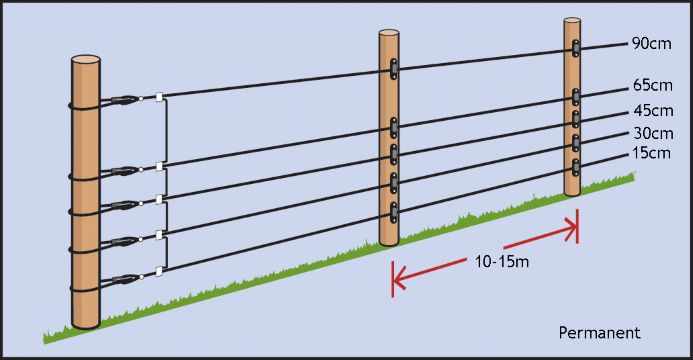
Temporary fencing
If setting up temporary fencing, you will usually need up to three strands of wire. Place the lowest two strands at 25 cm intervals from the ground, e.g. 25 cm, 50 cm and 75 cm. The lowest wire should be kept as high as possible to minimise risk of shorting.
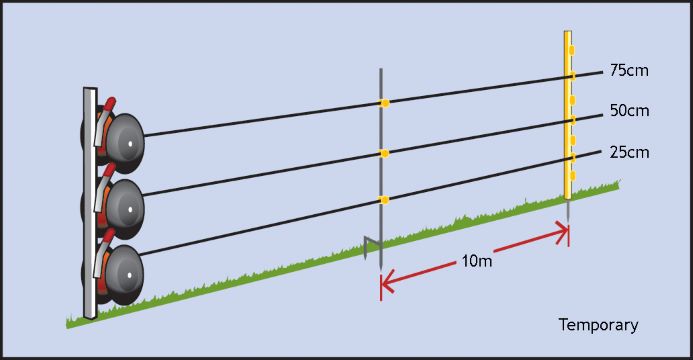
Gateways
Plan the location of the gate – it needs to have an insulated gate hook with tape or a spring to prevent stock crossing when it is shut. A gateway needs an insulator on the handle and on the opposite side, to maintain the electrical connection from the fence to the gate.
For permanent electric fences, bury the insulated power cable underground at a depth of 30 cm, in a rigid plastic pipe to prevent damage from traffic. Position the ends of the pipe downwards to stop water entering.
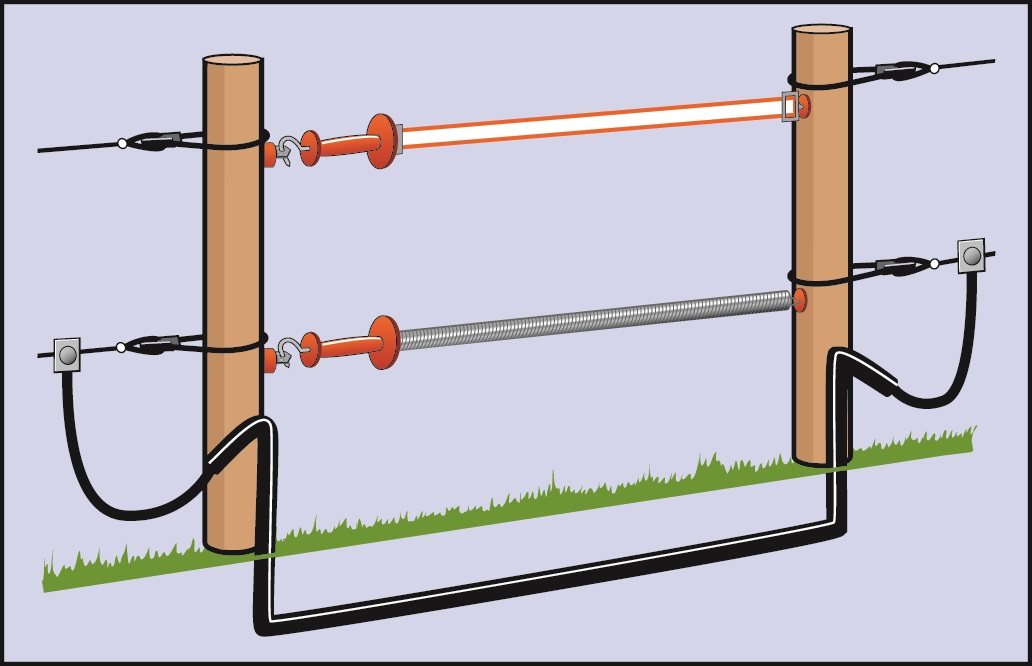
For temporary fences, there should only be one gateway – place at the end of the line.
If you are using polywire and fibreglass posts, the wire can be ‘pegged down’ or ‘held up’ using special posts that allow stock to cross over or under the live wires anywhere in the fence line.
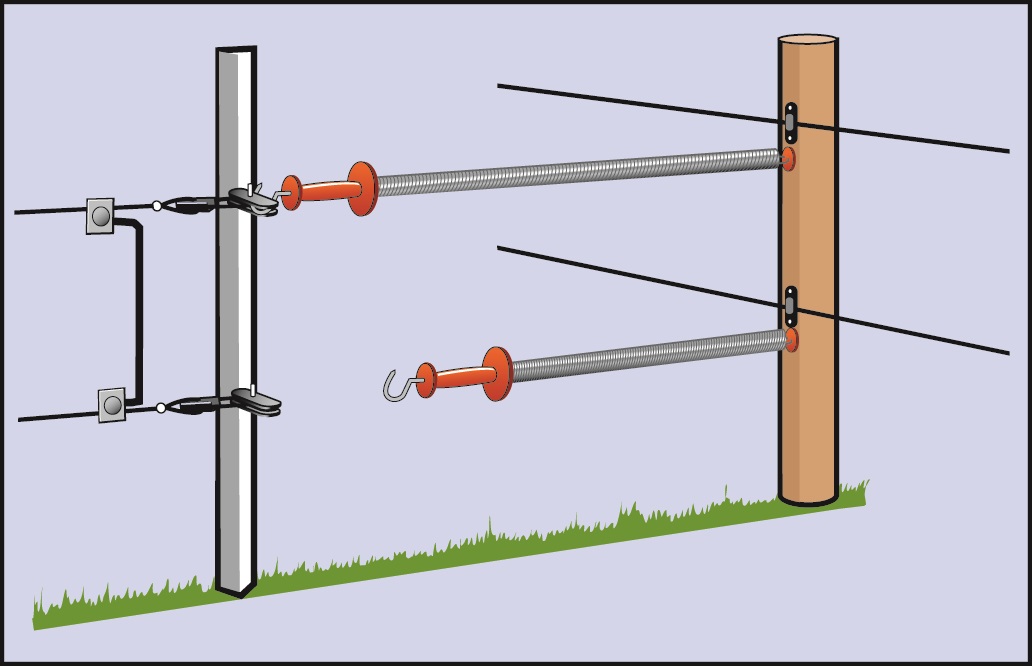
Note: Diagrams kindly provided by Rappa.
Common pitfalls
- Poor earth connection – increase the number of ground rods
- Stock challenging fences – ensure stock are trained to fence and consider putting flags on the fence for visibility
- Broken insulators – source insulators treated to resist UV light degradation; alternatively, fence tension may be too high or posts too close together
- Wet foliage interrupting shock – connect lower fence wires separately so power can be disconnected when grass gets too tall, or spray off the grass under the fence line
- Shock issues with wire – thin wire will not carry electricity as well as thicker wire; also ensure wires are at least 13 cm apart
Need more information? See our advice:
Types of electric fencing for cattle and sheep
Components of an electric fence
Training cattle and sheep to an electric fence
Identifying a fault
If there is a problem with a fence, follow this process until the fence fault is identified:
- Measure the voltage on the fence line
- Check the energiser is working correctly
- Check the earth
- Check the connections
- Check the fence line with a fault finder
Health and safety
Always read the information that comes with the energiser to prevent damage or injury during installation. Always install the correct energiser model for the power source.
Do:
- Display warning signs on all electric fences. If they are near public footpaths, signs should be erected every 50 metres or less
- Discuss any electric fence erection near a public right of way with the local authority
- Place a non-electrified gate or stile if a public footpath crosses an electric fence
- Make sure separate fences are at least two metres apart if powered by separate energisers
- Make sure mains energisers are under cover and out of reach of children
Do not:
- Use electric power poles to support electric fences
- Use power poles as an earth
- Electrify barbed wire or other material in which animals can get entangled
- Connect more than one energiser to a fence
- Run electric fences parallel with overhead power or communication lines, as this may induce a dangerous high voltage line onto the fence. If lines do have to be crossed, do so at a right angle

